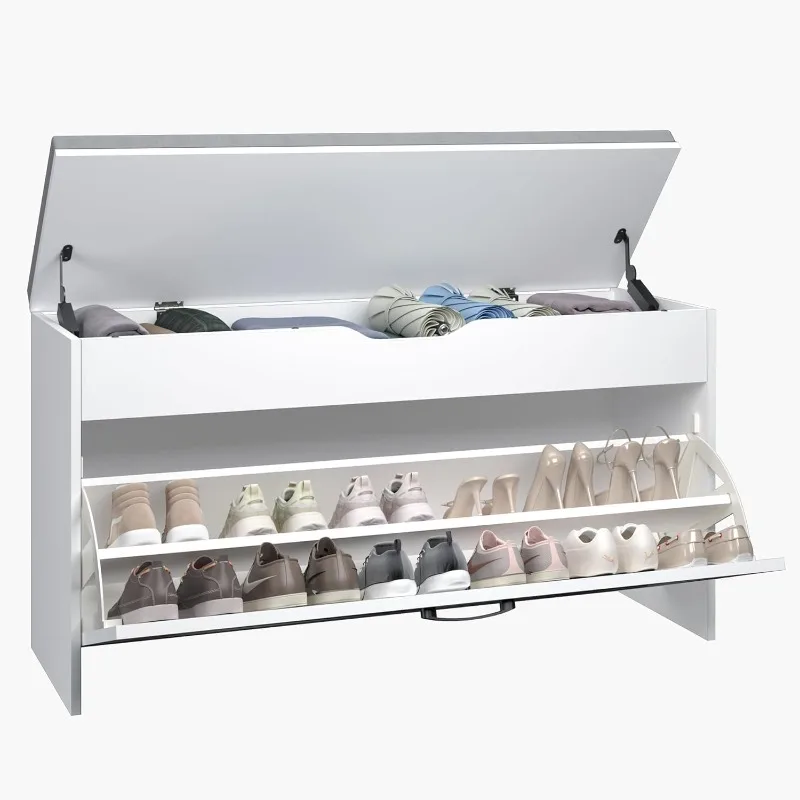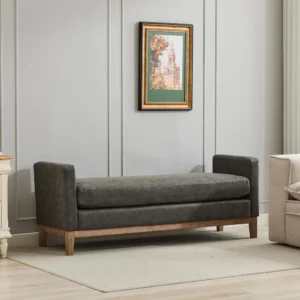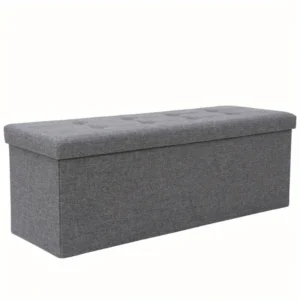Understanding the Power of Hallway Benches: Form Meets Function
The entryway sets the tone for your entire home. It’s the first space guests encounter and the transitional area that welcomes you back after a long day. Yet many hallways become cluttered catch-alls rather than organized, welcoming spaces. This is where the humble hallway bench becomes a surprisingly powerful solution.
Hallway benches transform entryways by serving multiple essential functions simultaneously:
- Practical seating for removing shoes, setting down bags, or pausing before heading out
- Valuable storage space for shoes, accessories, and seasonal items
- Stylish focal point that anchors your entryway’s design and creates a welcoming impression
What makes benches particularly effective for hallways is their versatility in both form and function. Unlike single-purpose furniture pieces, stylish storage benches for hallway areas create organization while enhancing your home’s aesthetic appeal. They solve common entryway challenges without demanding excessive space.
Studies show that organized entryways significantly reduce daily stress levels and improve home satisfaction. The simple act of having a dedicated place to store everyday items eliminates the frantic morning search for keys, bags, and shoes. Additionally, a welcoming, organized entrance creates a psychological transition from the outside world to your personal sanctuary.
Our diverse collection of entryway benches offers solutions for various hallway configurations and storage needs. The key is finding the perfect balance between functionality and style that complements your home’s unique characteristics.
Assessing Your Space: Finding the Perfect Bench Fit
Before rushing to purchase a hallway bench, taking proper measurements ensures you’ll select a piece that enhances rather than hinders your space. Start by measuring your hallway’s width, length, and any architectural features that might impact bench placement.
For comfortable movement, maintain these crucial clearances:
– Minimum 36 inches (91 cm) of walkway width for single-file traffic
– At least 42 inches (107 cm) for comfortable two-person passing
– Allow 24 inches (61 cm) of space in front of the bench for sitting and standing
Beyond basic measurements, consider how traffic naturally flows through your hallway. Where do people pause? Where do bottlenecks occur during busy mornings? Understanding these patterns helps determine optimal bench placement.
Next, identify your primary entryway needs by asking:
– What items regularly create clutter in your hallway?
– How many family members need space for their belongings?
– Do you need more seating or more storage?
– Does your entryway serve multiple functions (home office entry, mudroom, etc.)?
The answers will guide you toward specific bench features that address your unique challenges. For instance, homes with children might prioritize sturdy what size hallway bench dimensions that accommodate multiple users simultaneously.
Finally, evaluate your hallway’s style elements. What colors, materials, and textures already exist in the space? Your bench should complement these elements while still fulfilling its practical purpose. Whether you have limited floor space or an expansive foyer, our narrow entryway bench options can be tailored to your specific dimensions and style preferences.
Essential Types of Hallway Benches: Storage Powerhouses
When maximizing hallway functionality, the type of storage your bench provides makes all the difference. Each design offers unique advantages depending on your organizational needs and space constraints.
Comparing Hallway Bench Storage Options
| Bench Type | Best For | Pros | Cons |
|---|---|---|---|
| Lift-top | Bulky items, seasonal gear | Conceals clutter, large capacity | Requires clearance to open |
| Drawer | Smaller accessories, papers | Easy access without moving items on top | Limited height for stored items |
| Cubby | Shoes, baskets, daily items | Visual organization, customizable | Items remain visible |
| Open-bottom | Shoes, boots, pet items | Airflow for wet items, easy cleaning | Limited concealment |
Lift-top storage benches offer the greatest volume for storing larger items like extra blankets, winter accessories, or rarely used equipment. The hidden storage keeps your hallway looking tidy while providing substantial capacity. However, you’ll need adequate space in front of the bench to fully open the top.
Drawer systems provide excellent organization for smaller items that tend to create entryway clutter. Keys, mail, gloves, and accessories stay neatly contained but easily accessible. Many homeowners prefer drawer storage because items can be retrieved without disturbing decorative elements displayed on the bench top.
Cubby-style benches have become increasingly popular for their versatility and visual organization. Standard cubbies typically accommodate 2-3 pairs of adult shoes per section, while larger compartments can hold baskets for corralling smaller items. This design works especially well for families needing designated spaces for each person’s belongings.
For high-traffic areas prone to wet, muddy shoes, open-bottom benches provide practical advantages. The space underneath allows air circulation for drying damp items while containing mess. These designs often feature slatted shelves that prevent dirt and debris from accumulating.
Material selection significantly impacts your bench’s longevity in this high-traffic area. Solid wood offers classic appeal and durability but may show scratches. Metal frames provide modern style and strength with minimal maintenance. Upholstered elements add comfort but require more regular cleaning in entryway environments.
Our top storage bench designs for entryways combine these practical features with aesthetic appeal to create functional focal points. For comprehensive solutions focusing specifically on organization, explore our entryway bench storage collection designed to maximize capacity while maintaining style.
Space-Saving Bench Designs for Narrow Hallways
Narrow hallways present unique challenges, but even the slimmest spaces can benefit from a well-chosen bench. The key is selecting proportional pieces designed specifically for compact areas.
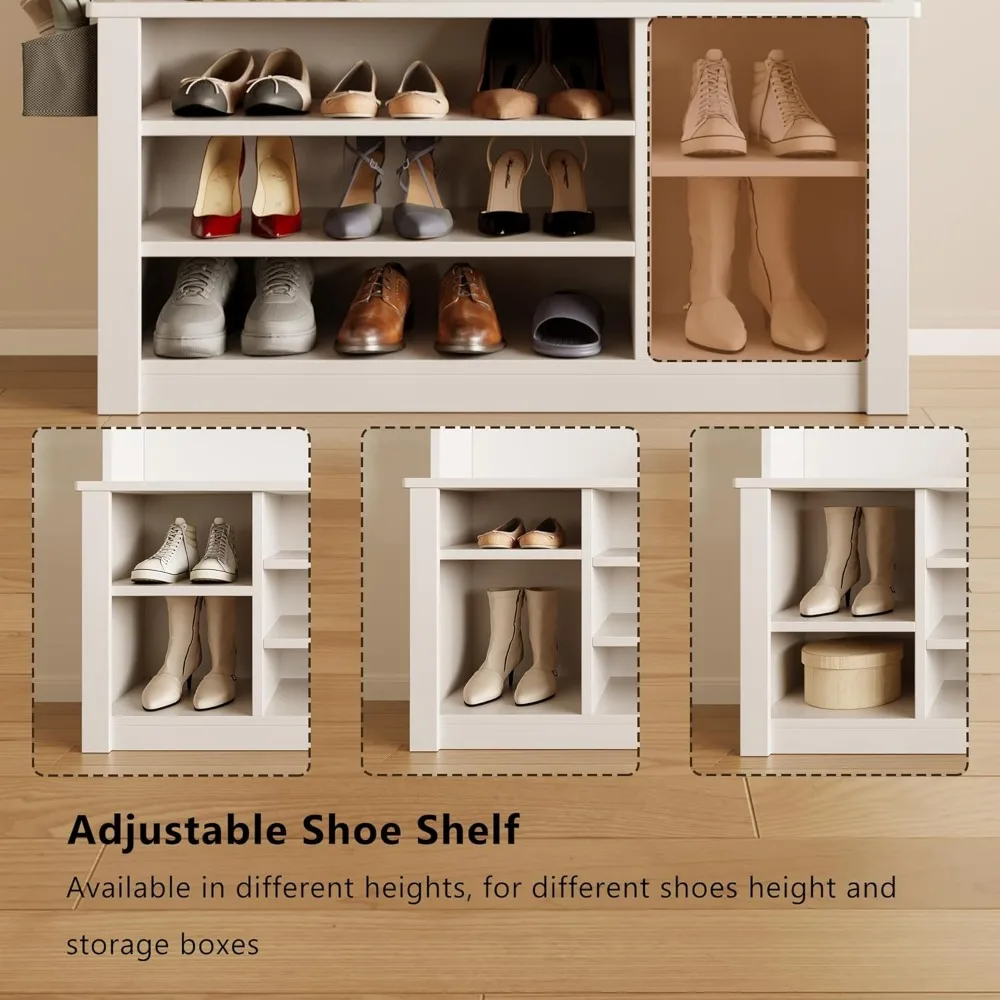
For truly narrow passages, look for benches with these space-conscious dimensions:
– Depth of 12-14 inches (30-36 cm) instead of standard 16-18 inches (41-46 cm)
– Height around 18 inches (46 cm) for comfortable seating without overwhelming the space
– Length proportional to your available wall space, with options as compact as 24 inches (61 cm)
Several design elements can make benches appear lighter and less imposing in tight spaces:
- Raised legs create an airy feel by showing more floor beneath the bench
- Backless designs reduce visual bulk while maintaining functionality
- Lighter finishes reflect more light, contributing to a more spacious feel
- Glass or acrylic components create transparency that visually expands the space
When choosing the perfect bench for a narrow hallway, consider how its profile impacts perception. Straight lines and lower profiles often work better than ornate designs with substantial height. Some homeowners have transformed hallways as narrow as 3 feet (91 cm) into functional entryways using sleek, wall-hugging benches combined with strategic organization systems.
Storage integration becomes even more crucial in narrow spaces. Look for slim designs with vertical storage elements that maximize capacity without expanding the footprint. Drawer systems that don’t require pull-out clearance work particularly well, as do benches with storage accessed from the top rather than the front.
Our collection of small entryway bench options includes numerous slim-profile designs specifically engineered for narrow spaces. These pieces prove that even the most challenging hallways can become organized, welcoming entryways with the right bench solution.
Wall-Mounted and Built-In Solutions: Maximizing Every Inch
For ultimate space efficiency, wall-mounted and built-in bench solutions offer compelling advantages. By eliminating legs and integrating directly with your architecture, these options free up valuable floor space while providing the same practical benefits.
Wall-mounted floating benches create a sleek, contemporary look while making cleaning underneath effortless. When installing these space-saving solutions, consider:
- Structural support: Ensure mounting into wall studs or using appropriate anchors
- Weight capacity: Most properly installed floating benches support 250-400 pounds (113-181 kg)
- Height placement: Standard seat height of 17-19 inches (43-48 cm) from the floor
- Depth considerations: Allow at least 14 inches (36 cm) of depth for comfortable seating
Built-in bench solutions take customization further by utilizing existing architectural features. Window seats can be transformed into entryway benches with added storage. Awkward corners or recessed areas become perfect opportunities for custom bench installations that maximize otherwise wasted space.
The visual impact of these solutions extends beyond practical storage. Wall-mounted and built-in benches create clean lines that make small hallways appear more spacious and purposeful. For contemporary homes especially, the floating effect contributes to a minimalist aesthetic while maintaining full functionality.
When designing small hallways with slim benches, consider how wall-mounting might transform your space. The few inches gained by eliminating legs and using wall space more efficiently can make a substantial difference in tight hallways.
Installation complexity varies by design. While some floating benches can be managed as weekend DIY projects, others—particularly built-ins—might require professional carpentry. The investment typically pays dividends in both space optimization and home value enhancement.
Vertical Integration: Creating a Complete Entryway System
The most effective hallway solutions don’t stop at bench level—they utilize vertical space to create comprehensive organization systems. By thinking upward, you can multiply your storage capacity without expanding your bench’s footprint.
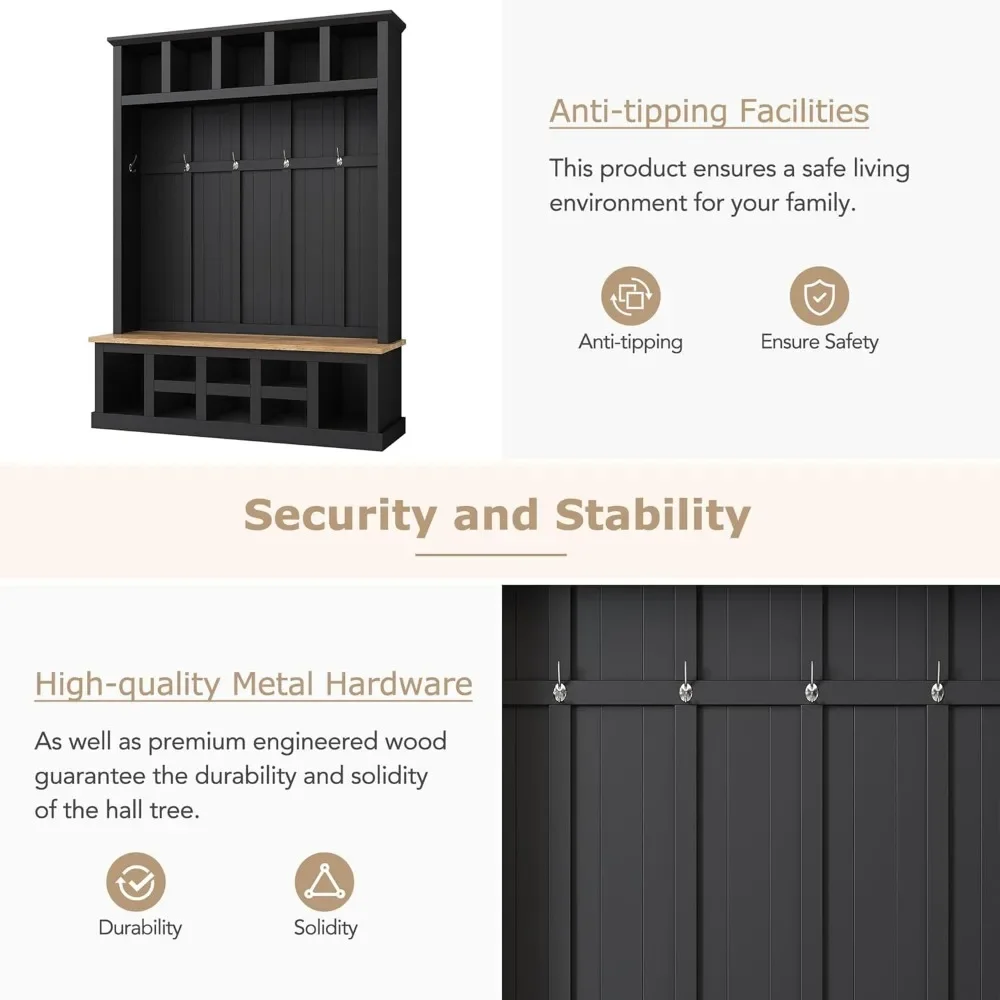
Strategic vertical elements to consider include:
- Hook systems mounted at 60 inches (152 cm) height for coats and bags
- Shelving above benches for decorative elements or seasonal items
- Wall cabinets for concealing items that would otherwise create visual clutter
- Mirror placement at eye level (approximately 65 inches or 165 cm center height)
Integrated hall tree systems combine these elements into cohesive units, often incorporating bench seating at the base with hooks, shelves, and sometimes mirrors above. These comprehensive solutions are particularly valuable in homes without dedicated coat closets or where entryway storage needs exceed available floor space.
Lighting integration further enhances these vertical systems. Wall sconces flanking mirrors provide both functional illumination and ambiance. Under-shelf lighting can highlight decorative elements while improving visibility for finding stored items. Even simple plug-in options can dramatically improve both functionality and atmosphere.
Our collection of hall trees and coat rack benches offers various configurations to suit different spaces and storage needs. These complete systems solve multiple organizational challenges simultaneously while creating a cohesive entryway aesthetic.
For homes with significant storage demands, exploring ultimate hall tree storage bench options provides integrated solutions that maximize both horizontal and vertical space. These comprehensive units transform even modest hallways into organizational powerhouses with dedicated space for every entryway essential.
Design Harmony: Selecting Benches That Complement Your Home
A hallway bench should feel like a natural extension of your home’s design language rather than an afterthought. Selecting styles, materials, and finishes that harmonize with your existing aesthetic creates cohesion between your entryway and adjoining spaces.
For modern and minimalist homes, look for:
– Clean lines and simple silhouettes
– Materials like brushed metal, glass, and engineered wood
– Neutral color palettes with perhaps one bold accent
– Minimal ornamentation and hardware
Traditional and transitional homes benefit from:
– Classic forms with subtle detailing
– Solid wood construction in warm, rich finishes
– Softly upholstered seating surfaces
– Thoughtful decorative elements like turned legs or paneling
Farmhouse and rustic styles call for:
– Distressed or reclaimed wood elements
– Metal accents with antiqued or blackened finishes
– Textural elements like woven baskets or fabric cushions
– Details that suggest handcrafted quality
Beyond aesthetics, material selection should account for your household’s practical needs. Homes with children and pets benefit from durable, easy-clean surfaces like vinyl upholstery or sealed wood. Adult households might prioritize luxurious textiles and fine woodwork that require more careful maintenance.
Color strategy plays a crucial role in hallway bench selection. Lighter finishes visually expand tight spaces, while darker tones create grounding focal points in larger entryways. Consider how your bench color relates to both wall colors and flooring to create either harmonious continuity or deliberate contrast.
When decorating storage benches in hallways, the finishing touches matter tremendously. Cushions, baskets, and decorative objects should enhance functionality while expressing your personal style. These elements can be easily swapped seasonally to refresh your entryway’s appearance without replacing furniture.
Strategic Placement: Positioning for Maximum Effect
Where you position your hallway bench significantly impacts both its functionality and your space’s overall flow. Thoughtful placement transforms a simple furniture piece into an architectural element that defines and enhances your entryway.
For standard rectangular hallways, consider these placement strategies:
- Against the longest uninterrupted wall to maintain clear pathways
- Centered beneath windows if available, creating a natural focal point
- Opposite the entry door to create balance and prevent crowding the entrance
- Adjacent to stairways to provide a transition zone for removing shoes
Regardless of position, maintain these critical clearances:
– Minimum 24 inches (61 cm) of space in front of the bench for comfortable seating
– At least 36 inches (91 cm) of walkway width alongside the bench
– Adequate door clearance (doors should open fully without obstruction)
Special architectural elements require thoughtful consideration. For hallways with radiators, look for benches with open bottoms that allow heat circulation. Window placements might suggest window-seat style arrangements that maximize natural light. Sloped ceilings in converted spaces might indicate angled or lower-profile designs.
Your bench can serve as either a subtle background element or a dramatic focal point depending on its position relative to sightlines. Placing a bench directly visible from the main entrance creates an immediate welcome statement, while positioning it along a side wall offers a more subtle reveal as visitors enter.
Modern hallway bench storage solutions often incorporate innovative placement ideas that maximize functionality without sacrificing style. These contemporary approaches frequently treat the bench as part of an intentional design composition rather than simply a place to sit.
Organization Systems: Maintaining Order Beyond the Bench
While a well-chosen bench forms the foundation of hallway organization, complementary systems help maintain order throughout the seasons and as family needs evolve.
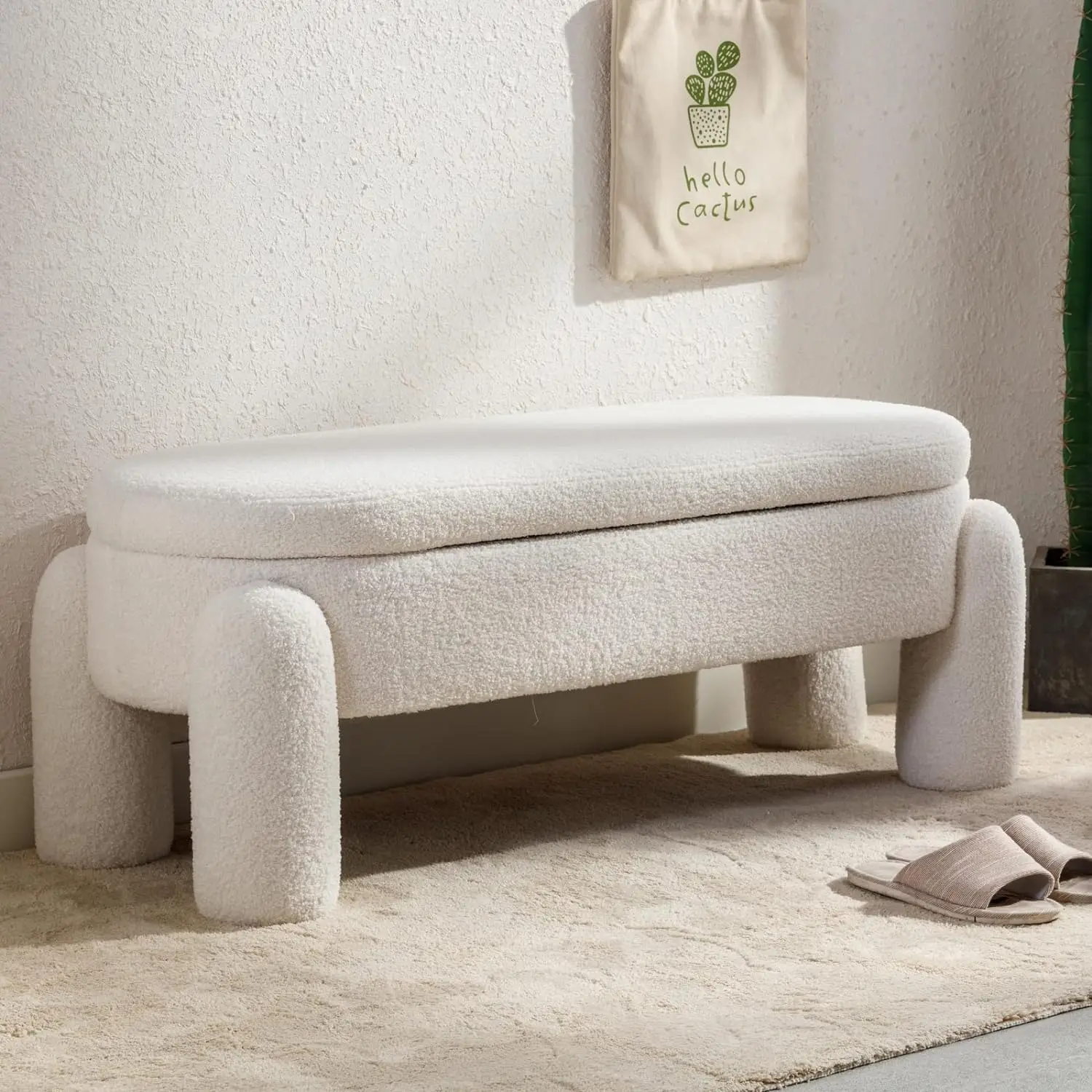
Enhance your bench’s storage capacity with these practical additions:
- Coordinated baskets for sorting items within cubbies or drawers
- Labeled containers to designate ownership or contents
- Tray organizers for corralling small items like keys and mail
- Under-bench shoe racks for additional footwear storage
For maximum organization efficiency, consider implementing these systems:
- Seasonal rotation schedule to swap winter boots for summer sandals
- One-in-one-out policy to prevent accessory accumulation
- Weekly reset routine to return misplaced items to their homes
- Family sorting system with designated spaces for each person
The most successful hallway organization strategies accommodate your family’s natural habits rather than fighting against them. If shoes inevitably end up kicked off at the door, create abundant, accessible shoe storage. If mail tends to accumulate, incorporate a specific sorting system within easy reach.
Entryway Bench with Cushion, Mudroom Bench with Cushion, Shoe Bench for Entryway
$1,186.63 Select options This product has multiple variants. The options may be chosen on the product pageCoat Rack Shoe Bench, Corner Entryway Bench, Corner Hall Tree, Shoe Bench for Entryway
$313.58 Select options This product has multiple variants. The options may be chosen on the product pageEntryway Bench with Back, Modern Entryway Bench, Shoe Bench for Entryway
Price range: $463.13 through $474.44 Select options This product has multiple variants. The options may be chosen on the product pageShoe Storage Bench for Entryway
$459.02 Select options This product has multiple variants. The options may be chosen on the product pageEntryway Bench with Shelf Storage, Shoe Bench for Entryway, Shoe Storage Bench
$194.08 Select options This product has multiple variants. The options may be chosen on the product pageCorner Entryway Bench, Entryway Bench with Cushion, Modern Entryway Bench, Shoe Bench for Entryway
$476.34 Select options This product has multiple variants. The options may be chosen on the product page
For families with extensive footwear collections, specialized shoe storage benches provide targeted solutions beyond standard bench designs. These purpose-built pieces maximize capacity for boots, athletic shoes, and everyday footwear while still offering comfortable seating.
The best organization systems grow with your family, adapting to changing needs throughout the year and as children grow. Modular components that can be reconfigured offer particular value in high-use areas like entryways where requirements frequently evolve.
Avoiding Common Mistakes: Ensuring Success with Your Hallway Bench
Even with careful planning, certain pitfalls commonly affect hallway bench implementations. Being aware of these challenges helps ensure your solution enhances rather than hinders your entryway experience.
The most frequent sizing errors include:
- Choosing benches too deep for narrow hallways (exceeding 16 inches or 41 cm in tight spaces)
- Selecting lengths that block doorways or crowd architectural features
- Underestimating clearance needed for comfortable passage (less than 36 inches or 91 cm)
- Misjudging storage capacity required for your household’s needs
Style missteps that undermine entryway appeal include:
- Mismatching wood tones with existing flooring or trim
- Selecting overly ornate pieces for simple, modern spaces
- Choosing lightweight designs inadequate for heavy daily use
- Ignoring the bench’s relationship to adjacent room aesthetics
Functionality failures often result from:
- Prioritizing appearance over practical needs specific to your household
- Inadequate storage division leading to disorganized piles
- Selecting materials unsuitable for high-traffic environments
- Overlooking maintenance requirements for upholstered elements
Many homeowners also underestimate the impact of proper lighting on their hallway bench area. Insufficient illumination makes storage areas difficult to use and diminishes the bench’s aesthetic contribution. Adding targeted lighting—whether through ceiling fixtures, wall sconces, or even battery-operated options—dramatically improves both functionality and atmosphere.
Regular maintenance routines ensure your hallway bench continues performing optimally. Seasonal deep cleaning, hardware tightening, and organization refreshes extend your investment’s lifespan while keeping your entryway welcoming.
Future-Proofing Your Entryway: Adaptable Bench Solutions
As household needs evolve, your entryway organization should adapt accordingly. Forward-thinking hallway bench solutions accommodate these changes without requiring complete replacement.
Consider these adaptability features when selecting your bench:
- Modular components that can be reconfigured or expanded
- Adjustable shelving heights to accommodate changing storage needs
- Removable cushions and covers that can be cleaned or replaced
- Neutral foundational pieces that support seasonal accessory changes
Seasonal adaptation strategies keep your entryway functional year-round:
- Winter: Increase boot storage, add basket for gloves/scarves, incorporate moisture-resistant elements
- Spring: Introduce umbrella storage, lightweight jacket hooks, mud-management solutions
- Summer: Maximize sandal storage, create sunscreen/hat station, simplify for vacation departures
- Fall: Reintroduce jacket storage, incorporate school supply organization, prepare for holiday guests
Growing families benefit particularly from forward-thinking bench solutions. Features that accommodate children’s changing heights, increasing independence, and evolving storage needs provide lasting value. Consider how lower hooks can be repositioned, how shoe storage might adapt from tiny sneakers to adult-sized sports equipment, and how organizational systems might eventually transfer ownership to children as they mature.
Cost-effective refresh strategies allow your entryway to evolve without major investments. New cushions, updated hardware, fresh baskets, and seasonal decorative elements transform your bench’s appearance while its functional foundation remains constant.
Quick Transformations: High-Impact Bench Updates
Already have a hallway bench that needs refreshing? These quick upgrades deliver significant improvements without major investments of time or money.
Weekend projects with dramatic results include:
- Repainting or restaining wooden bench components
- Replacing basic hardware with distinctive knobs or pulls
- Adding cushions in updated fabrics or patterns
- Installing organization inserts in existing storage compartments
For seasonal refreshes, consider these 15-minute transformations:
- Swap textiles (cushions, throws, small rugs) to reflect the season
- Rotate decorative elements on shelving above the bench
- Change basket liners or containers to introduce new colors
- Add functional accessories like boot trays or umbrella stands as needed
Organization resets maintain peak functionality with minimal effort:
- Empty all storage compartments and clean thoroughly
- Discard or relocate items that don’t belong in the entryway
- Regroup remaining items by frequency of use and logical categories
- Implement or refresh labeling systems for shared spaces
Visual styling refreshes maintain your entryway’s welcoming atmosphere:
- Update family photos in frames near the bench area
- Introduce seasonal natural elements (pine branches, fresh flowers)
- Adjust lighting to complement changing daylight hours
- Incorporate scent through subtle diffusers appropriate to the season
These quick improvements maintain your hallway bench as a functional focal point while allowing your entryway to evolve with your home’s overall aesthetic and your family’s changing needs.
Frequently Asked Questions: Hallway Bench Solutions
What’s the minimum width hallway that can accommodate a bench?
Hallways as narrow as 42 inches (107 cm) can incorporate slim bench designs if you select models with depths of 12-14 inches (30-36 cm). This maintains the recommended minimum 30 inches (76 cm) of passing space.
How do I know what size bench is right for my space?
Measure your available wall length, then select a bench that’s proportional while leaving at least 12 inches (30 cm) of space at each end for visual breathing room. Depth should allow for 36 inches (91 cm) of clearance for walkways.
What’s the best material for a family-friendly hallway bench?
Solid wood with durable finishes offers the best combination of longevity and maintainability for households with children. Look for washable cushion covers and sealed surfaces that resist moisture and scratches.
How can I maximize storage in an extremely small hallway?
Vertical integration is key. Select a narrow bench with storage, then utilize wall space above for hooks, shelving, and cabinets. Consider wall-mounted options that eliminate legs to free up visual and physical space.
What’s the ideal height for a comfortable hallway bench?
Standard bench height ranges from 17-19 inches (43-48 cm) from the floor to the top of the seating surface. This height accommodates most adults comfortably while allowing children to use the bench with reasonable ease.
How do I maintain different bench materials?
Wood: Dust regularly and treat with appropriate wood cleaner quarterly
Metal: Wipe with damp cloth and dry immediately to prevent corrosion
Upholstery: Vacuum regularly and clean spills promptly with appropriate fabric cleaner
Wicker/Rattan: Dust frequently and clean with slightly damp cloth, allowing to dry completely
By selecting the right hallway bench and implementing thoughtful organization systems, you can transform your entryway into a welcoming, efficient space that sets the perfect tone for your home. The combination of seating, storage, and style creates a functional focal point that enhances daily life while making a positive impression on everyone who enters.

